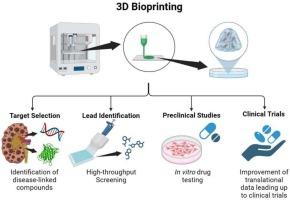Recent applications of three-dimensional bioprinting in drug discovery and development
IF 15.2
1区 医学
Q1 PHARMACOLOGY & PHARMACY
引用次数: 0
Abstract
The ability of three-dimensional (3D) bioprinting to fabricate biomimetic organ and disease models has been recognised to be promising for drug discovery and development as 3D bioprinted models can better mimic human physiology compared to two-dimensional (2D) cultures and animal models. This is useful for target selection where disease models can be studied to understand disease pathophysiology and identify disease-linked compounds. Lead identification and preclinical studies also benefit from 3D bioprinting as 3D bioprinted models can be utilised in high-throughput screening (HTS) systems and to produce efficacy and safety data that closely resembles clinical observations. Although no published applications of 3D bioprinting in clinical trials were found, there are two clinical trials planning to evaluate the predictive ability of 3D bioprinted models by comparing human and model responses to the same chemotherapy. Overall, this review provides a comprehensive summary of the latest applications of 3D bioprinting in drug discovery and development.

三维生物打印在药物研发中的最新应用。
与二维培养物和动物模型相比,三维生物打印模型能更好地模拟人体生理学,因此三维生物打印技术制造生物仿真器官和疾病模型的能力已被公认为有望用于药物发现和开发。这对靶点选择非常有用,通过研究疾病模型可以了解疾病的病理生理学,并确定与疾病相关的化合物。由于三维生物打印模型可用于高通量筛选(HTS)系统,并能产生与临床观察结果非常相似的药效和安全性数据,因此先导鉴定和临床前研究也能从三维生物打印技术中获益。虽然没有发现三维生物打印在临床试验中的公开应用,但有两项临床试验计划通过比较人体和模型对相同化疗的反应来评估三维生物打印模型的预测能力。总之,本综述全面总结了三维生物打印在药物发现和开发中的最新应用。
本文章由计算机程序翻译,如有差异,请以英文原文为准。
求助全文
约1分钟内获得全文
求助全文
来源期刊
CiteScore
28.10
自引率
5.00%
发文量
294
审稿时长
15.1 weeks
期刊介绍:
The aim of the Journal is to provide a forum for the critical analysis of advanced drug and gene delivery systems and their applications in human and veterinary medicine. The Journal has a broad scope, covering the key issues for effective drug and gene delivery, from administration to site-specific delivery.
In general, the Journal publishes review articles in a Theme Issue format. Each Theme Issue provides a comprehensive and critical examination of current and emerging research on the design and development of advanced drug and gene delivery systems and their application to experimental and clinical therapeutics. The goal is to illustrate the pivotal role of a multidisciplinary approach to modern drug delivery, encompassing the application of sound biological and physicochemical principles to the engineering of drug delivery systems to meet the therapeutic need at hand. Importantly the Editorial Team of ADDR asks that the authors effectively window the extensive volume of literature, pick the important contributions and explain their importance, produce a forward looking identification of the challenges facing the field and produce a Conclusions section with expert recommendations to address the issues.

 求助内容:
求助内容: 应助结果提醒方式:
应助结果提醒方式:


